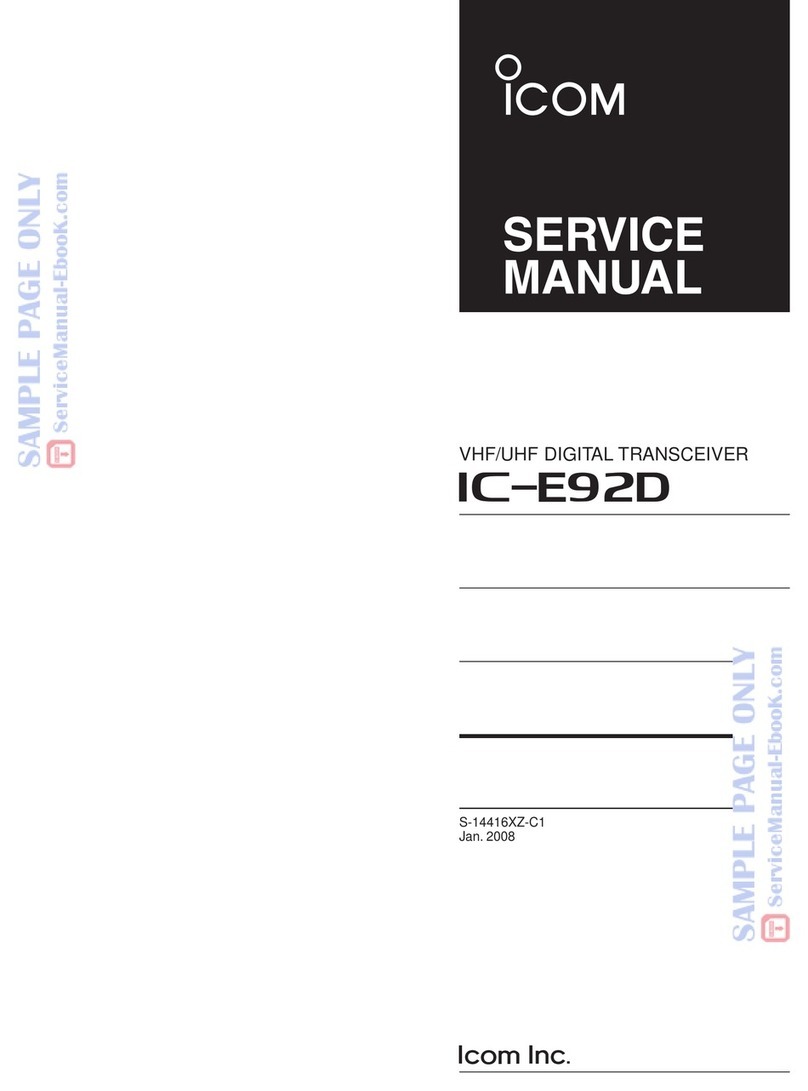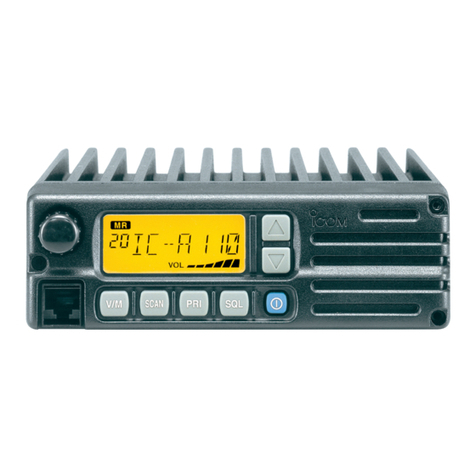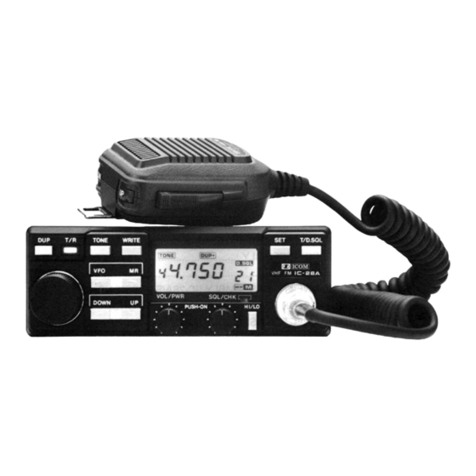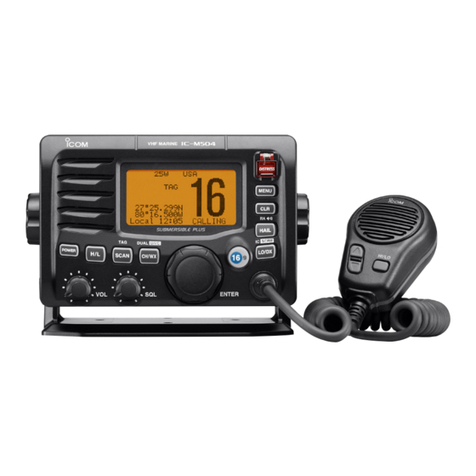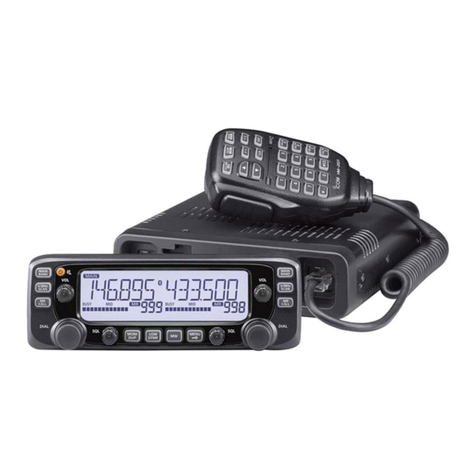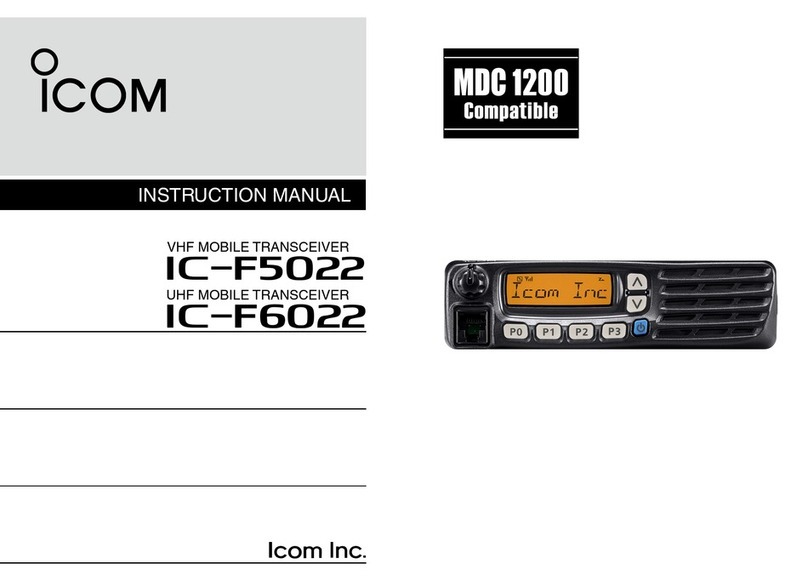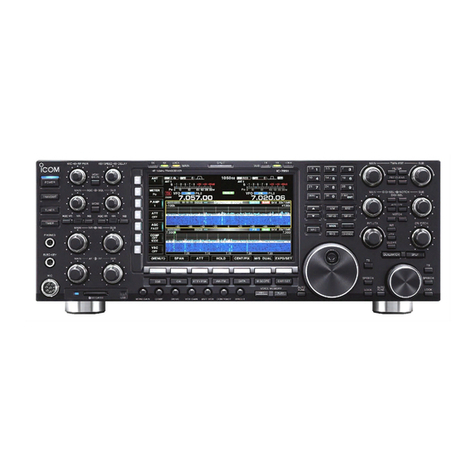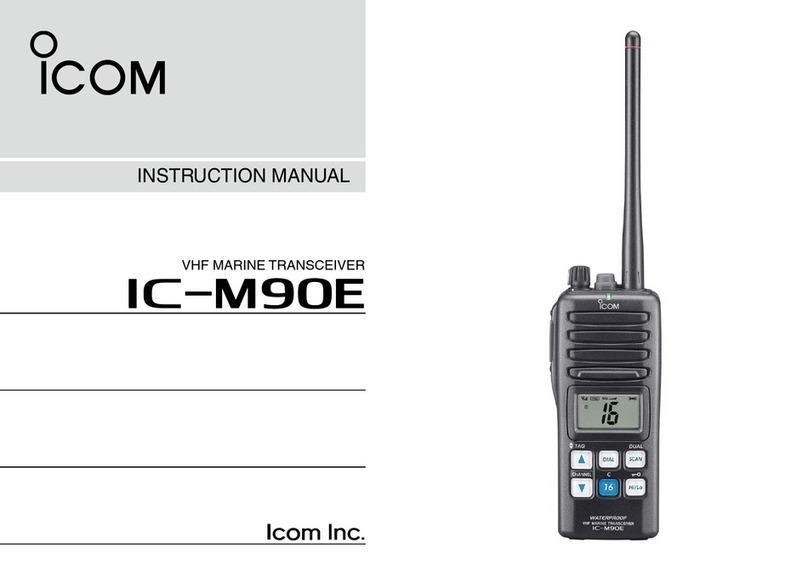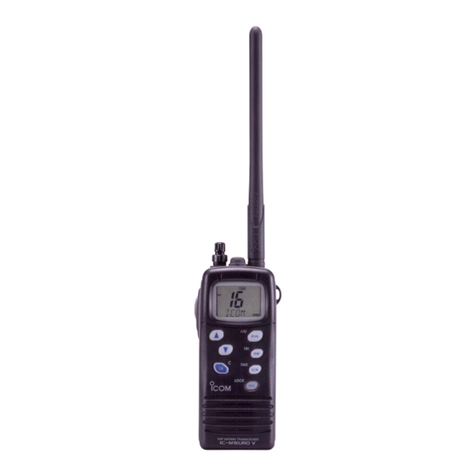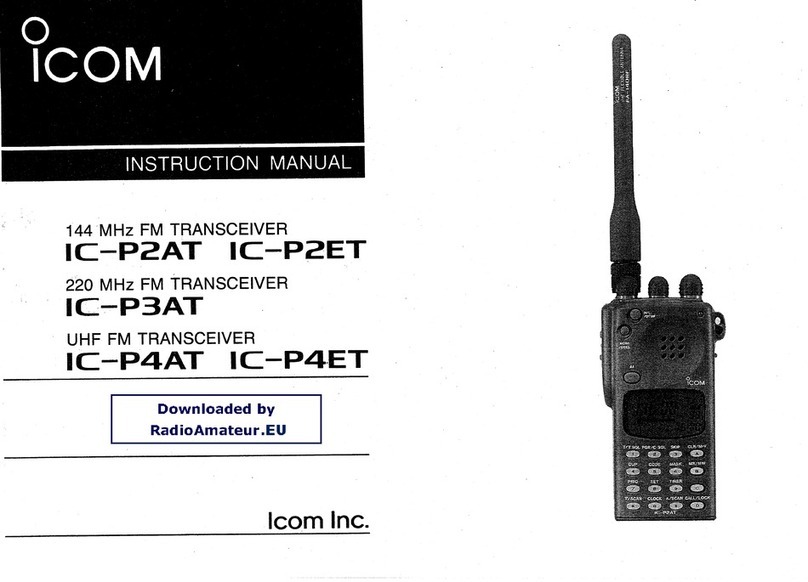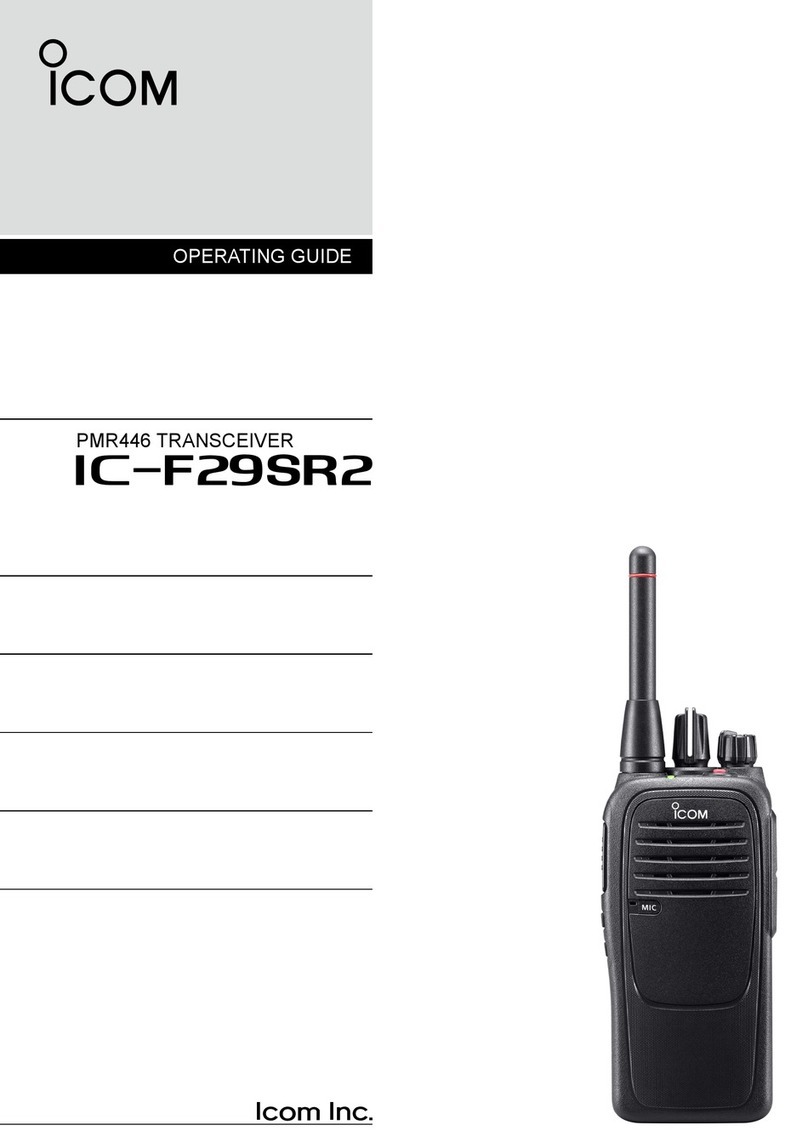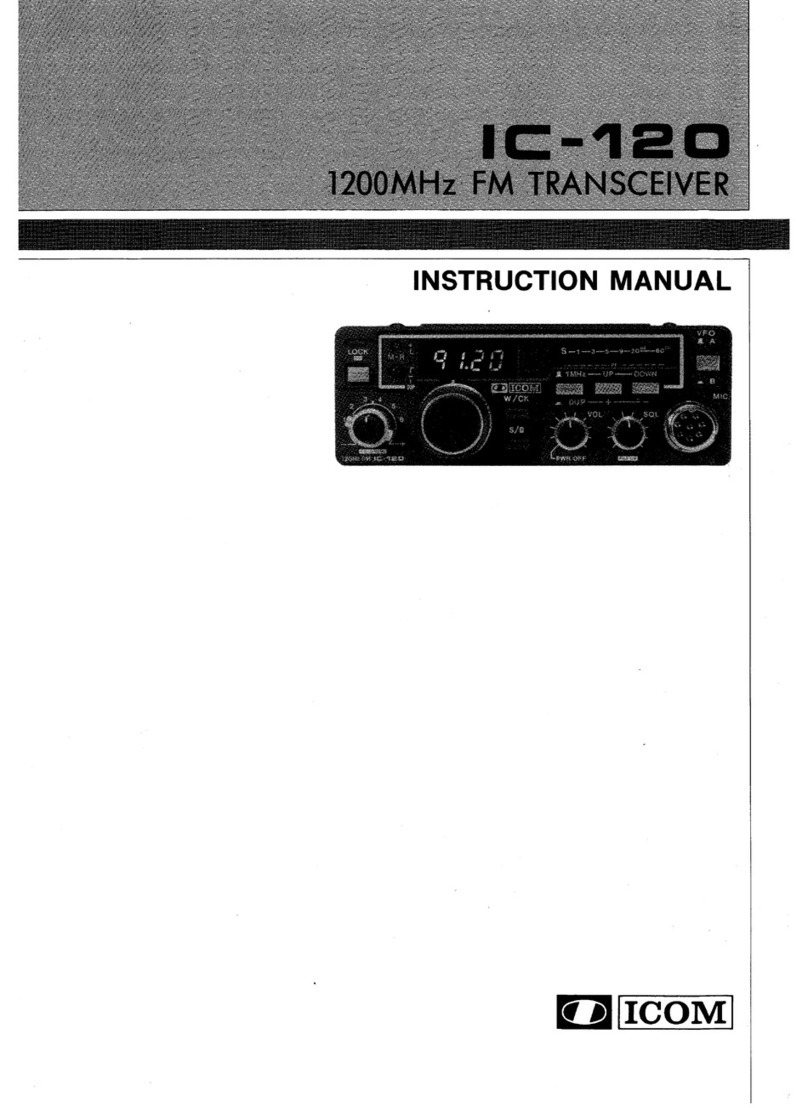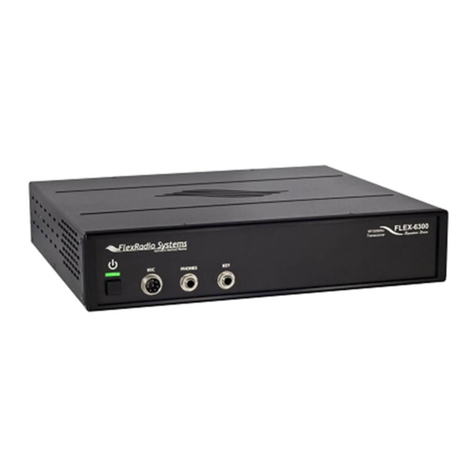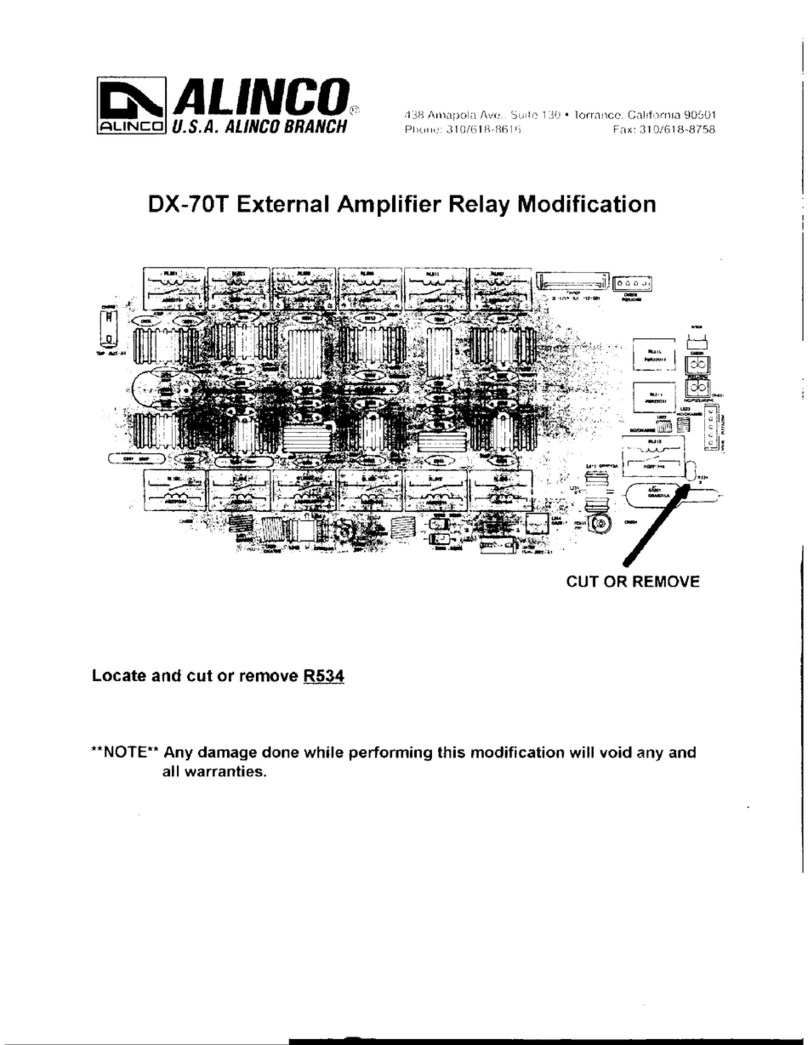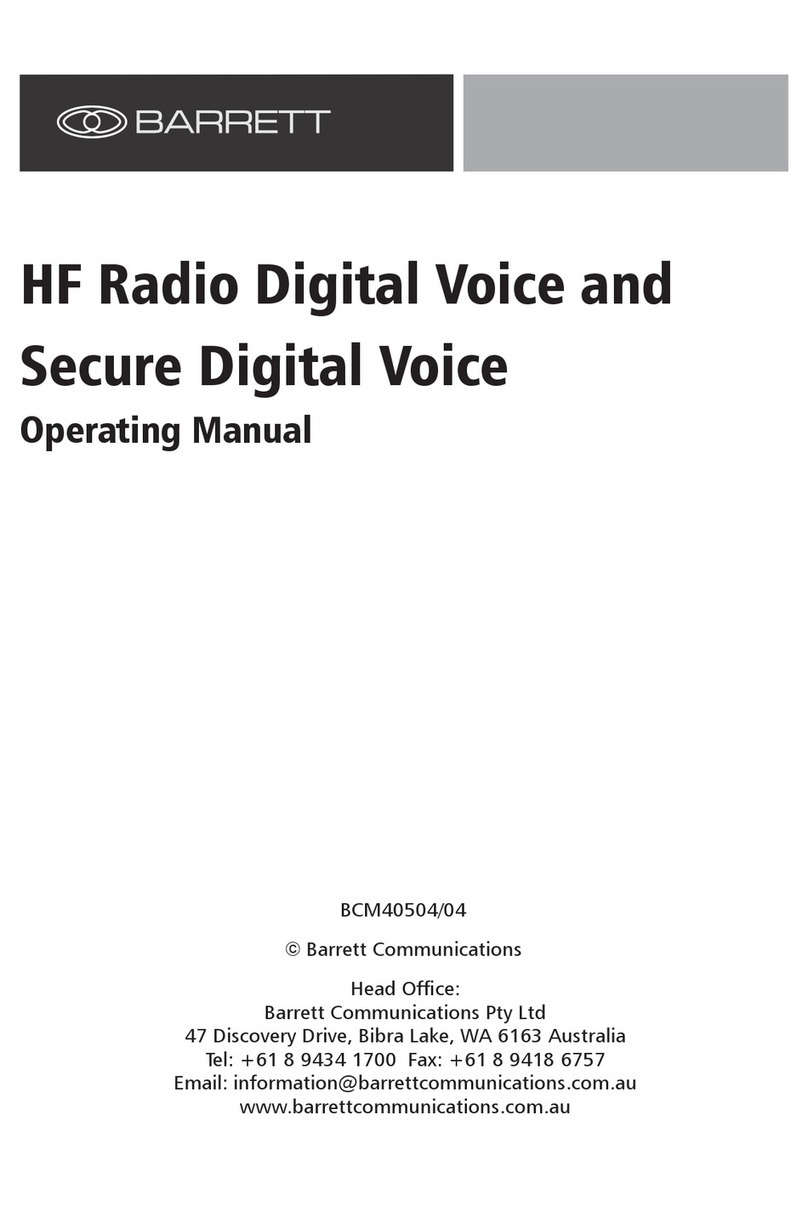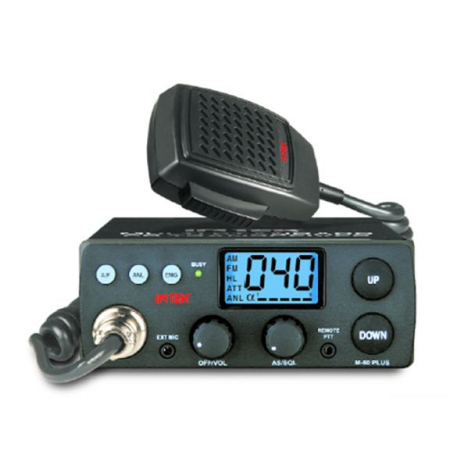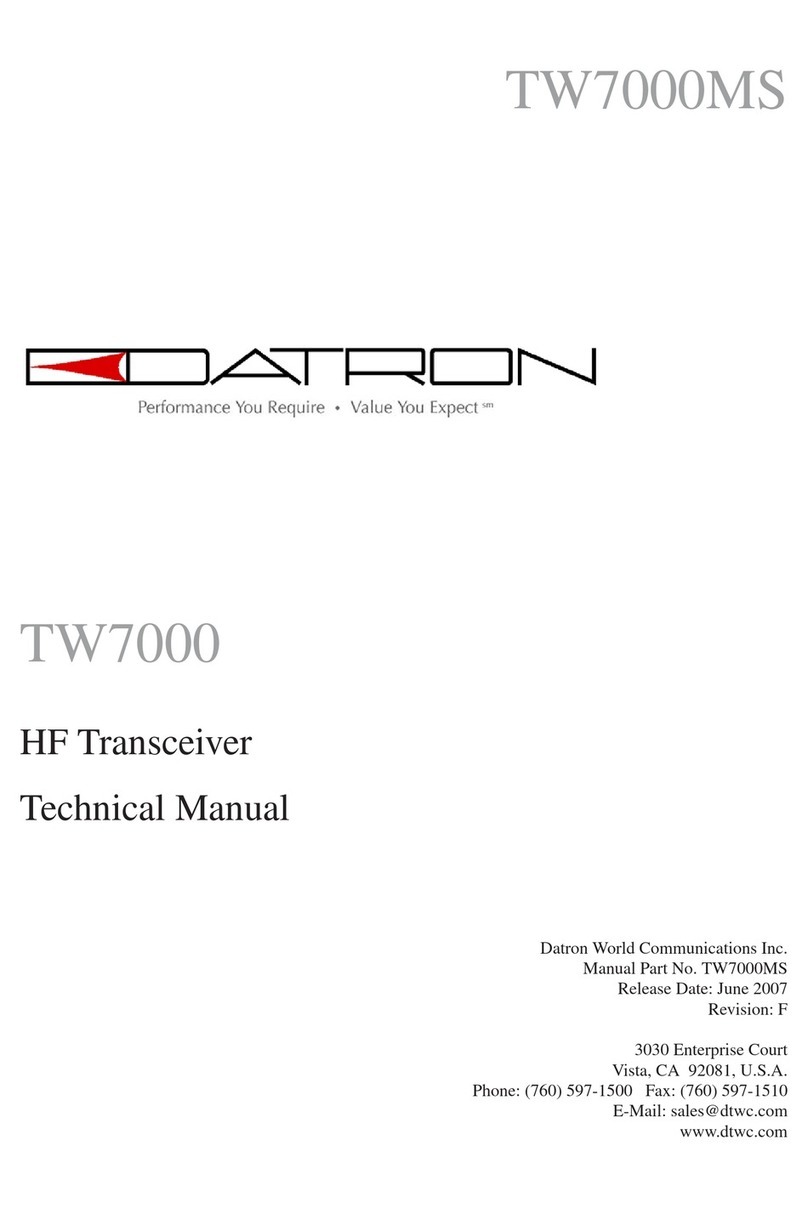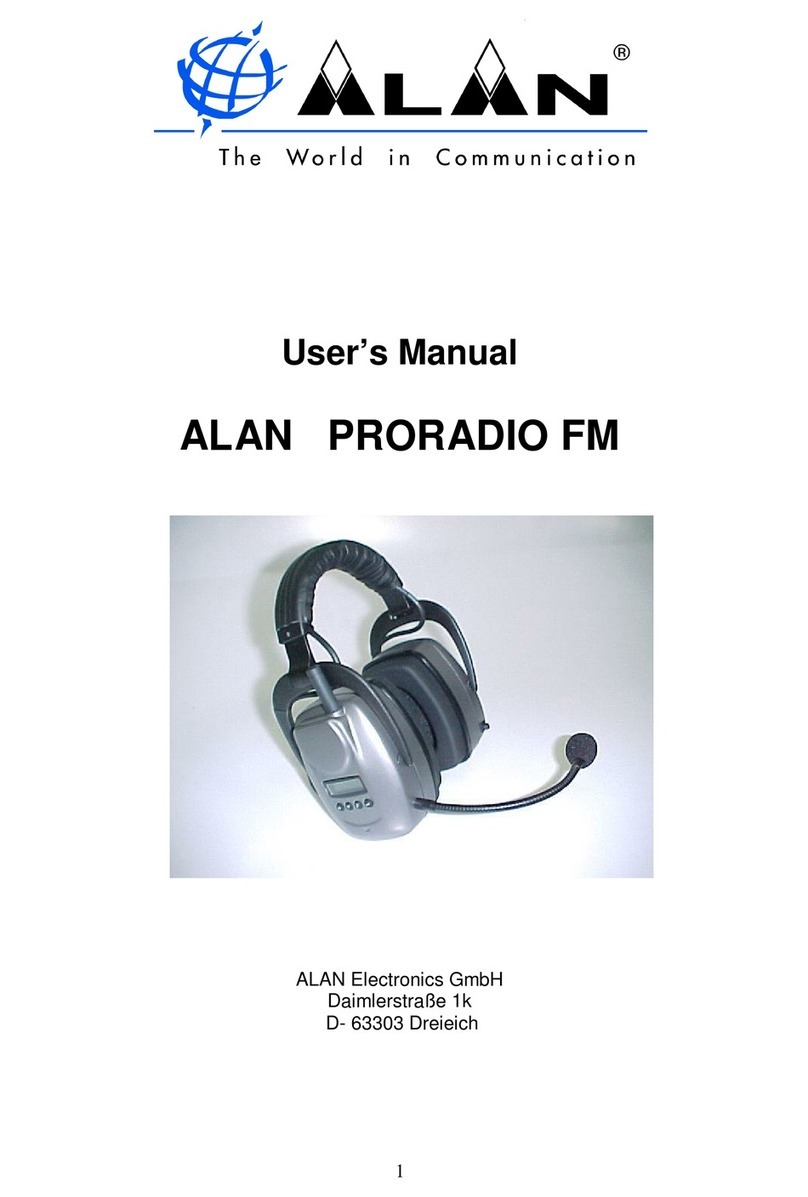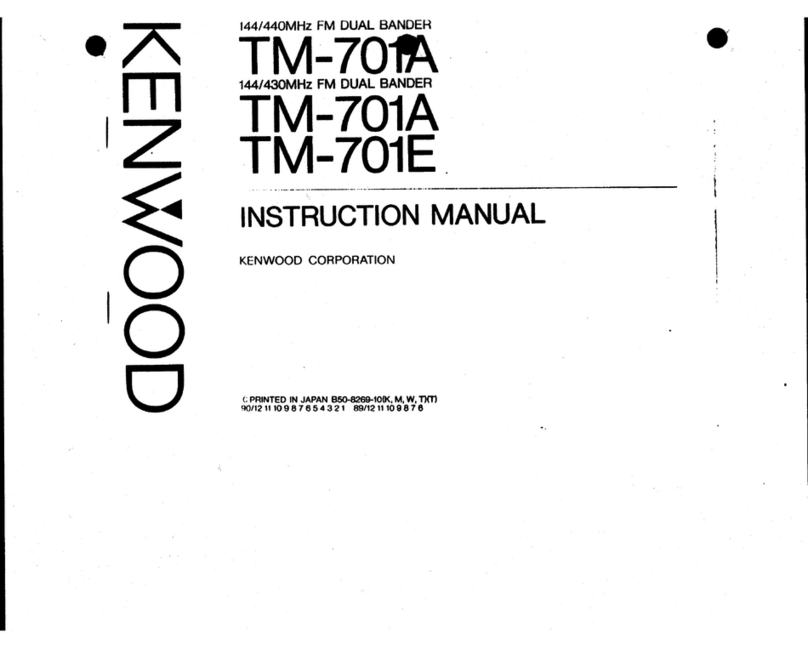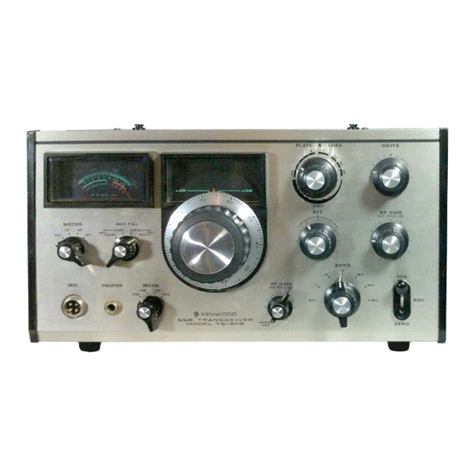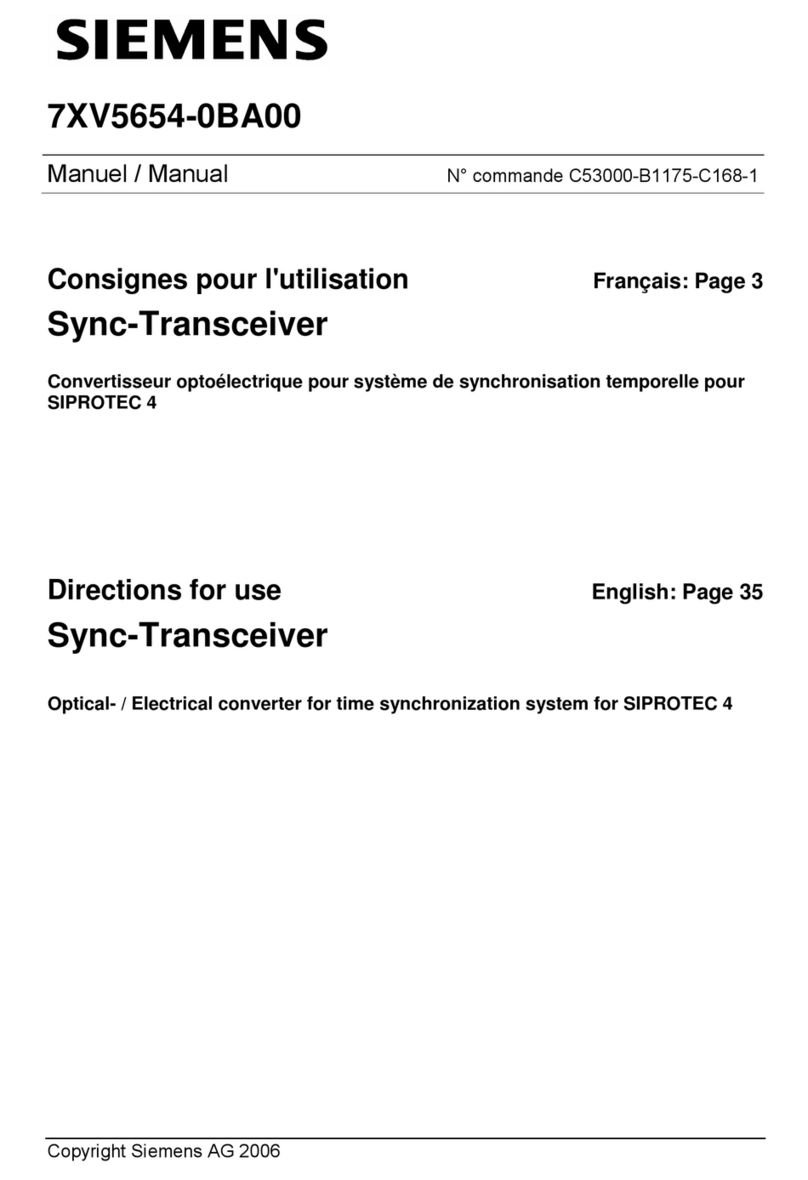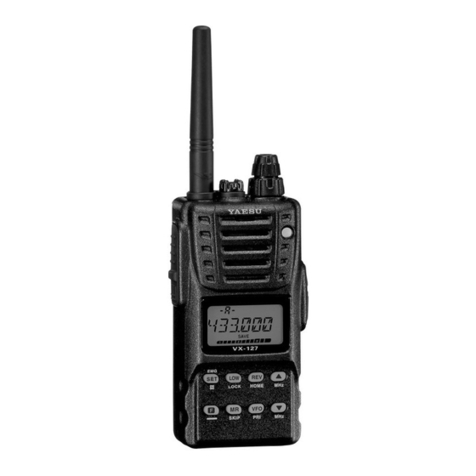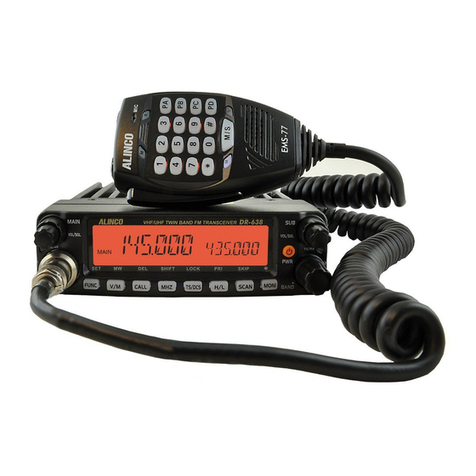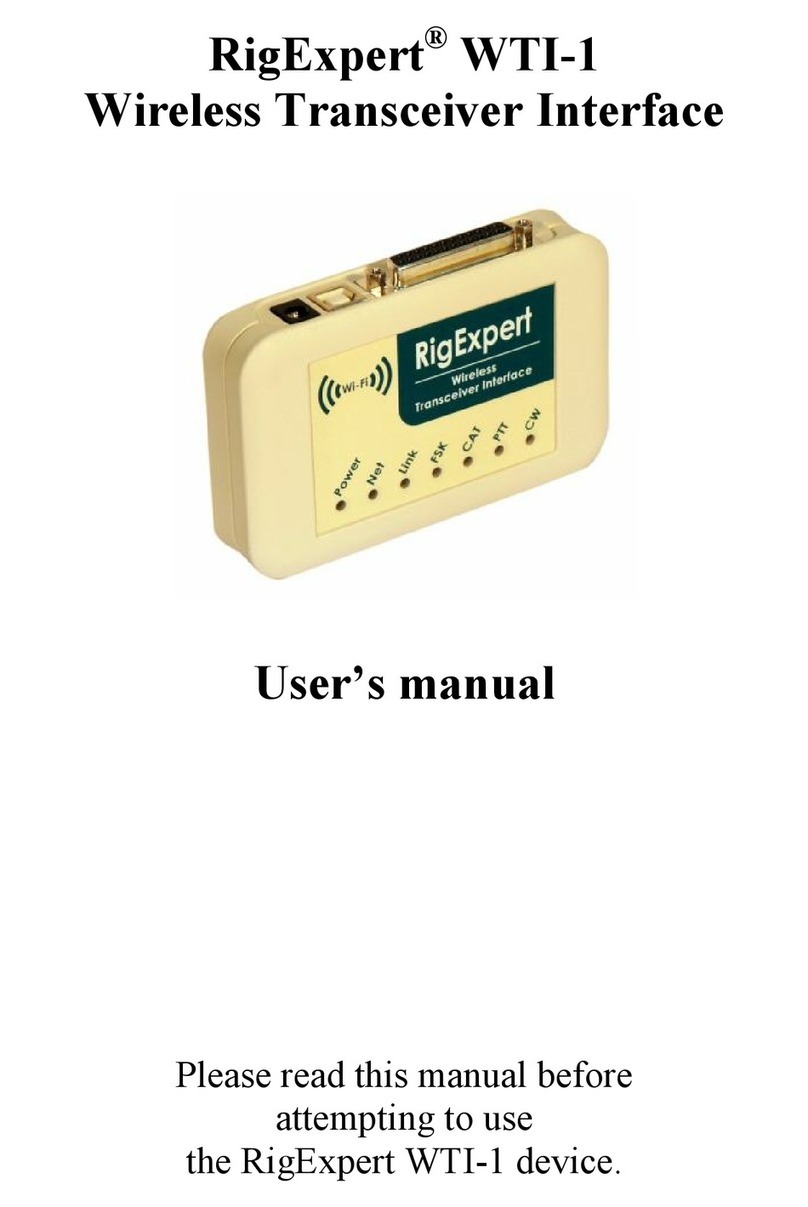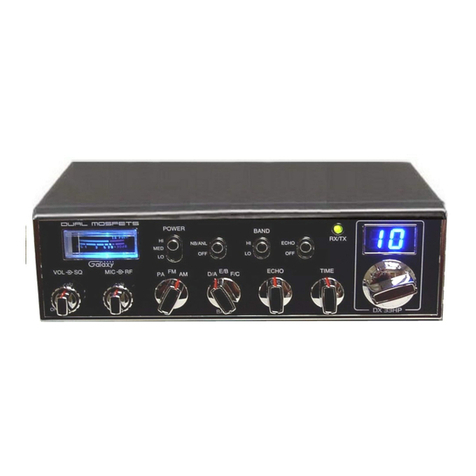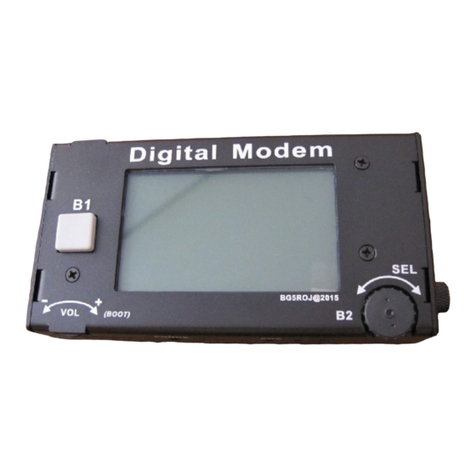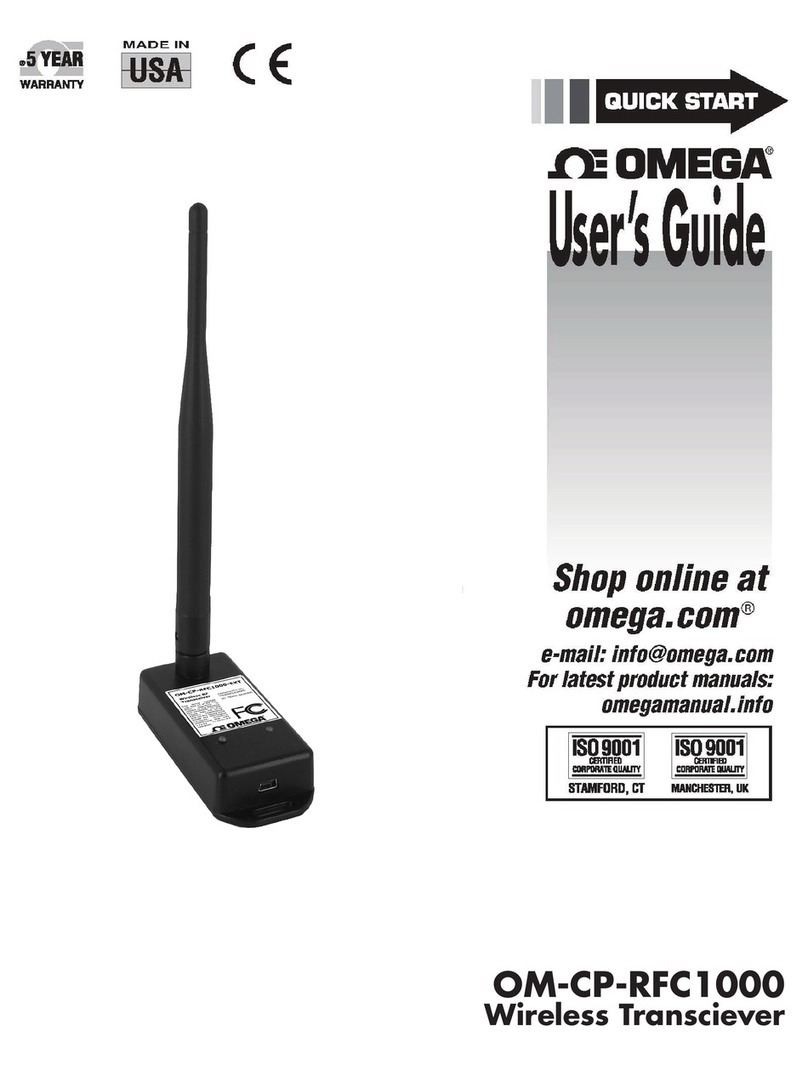Icom IC-E7 User manual

INSTRUCTION MANUAL
iE7
VHF/UHF DUAL BAND FM TRANSCEIVER
This device complies with Part 15 of the FCC rules. Operation is sub-
ject to the following two conditions: (1) This device may not cause
harmful interference, and (2) this device must accept any interference
received, including interference that may cause undesired operation.
WARNING: MODIFICATION OF THIS DEVICE TO RECEIVE CEL-
LULAR RADIO TELEPHONE SERVICE SIGNALS IS PROHIBITED
UNDER FCC RULES AND FEDERAL LAW.

i
New2001
FOREWORD
Thank you for purchasing this Icom product. The IC-E7 v h f /u h f
d u a l band f m transceiver is designed and built with Icom’s
superior technology and craftsmanship. With proper care, this
product should provide you with years of trouble-free operation.
We want to take a couple of moments of your time to thank you
for making your IC-E7 your radio of choice, and hope you agree
with Icom’s philosophy of “technology first.” Many hours of re-
search and development went into the design of your IC-E7.
DFEATURES
❍Covers the 0.495–999.990 MHz* frequency range
*Some frequency bands are disabled according to version
❍CTCSS and DTCS encoder/decoder standard
❍1250 memory channels* with 18 banks available
*200 auto write and 50 scan edge channels are included.
❍1800 mAh large capacity Li-Ion battery standard
IMPORTANT
READ ALL INSTRUCTIONS carefully and completely
before using the transceiver.
SAVE THIS INSTRUCTION MANUAL— This in-
struction manual contains important operating instructions
for the IC-E7.
EXPLICIT DEFINITIONS
WORD DEFINITION
RDANGER! Personal death, serious injury or an explo-
sion may occur.
RWARNING! Personal injury, fire hazard or electric
shock may occur.
CAUTION Equipment damage may occur.
NOTE
If disregarded, inconvenience only. No risk
of personal injury, fire or electric shock.
DISPOSAL
The crossed-out wheeled-bin symbol on your
product, literature, or packaging reminds you that
in the European Union, all electrical and elec-
tronic products, batteries, and accumulators (re-
chargeable batteries) must be taken to designated
collection locations at the end of their working life.
Do not dispose of these products as unsorted municipal waste.
Dispose of them according to the laws in your area.
Icom, Icom Inc. and Icom logo are registered trademarks of Icom Incorpo-
rated (Japan) in Japan, the United States, the United Kingdom, Germany,
France, Spain, Russia, Australia, New Zealand, and/or other countries.

ii
New2001
PRECAUTIONS
RDANGER! NEVER short the terminals of the trans-
ceiver or battery pack.
RDANGER! Use and charge only specified Icom battery
packs with Icom radios or Icom chargers. Only Icom battery
packs are tested and approved for use with Icom radios or
charged with Icom chargers. Using third-party or counterfeit
battery packs or chargers may cause smoke, fire, or cause
the battery to burst.
RWARNING RF EXPOSURE! This device emits Radio
Frequency (RF) energy. Caution should be observed when
operating this device. If you have any questions regarding RF
exposure and safety standards please refer to the Federal Com-
munications Commission Office of Engineering and Technology’s
report on Evaluating Compliance with FCC Guidelines for Human
Radio Frequency Electromagnetic Fields (OET Bulletin 65)
RWARNING! NEVER hold the transceiver so that the
antenna is very close to, or touching exposed parts of the
body, especially the face or eyes, while transmitting. The
transceiver will perform best if the microphone is 5 to 10 cm (2
to 4 inches) away from the lips and the transceiver is vertical.
RWARNING! NEVER operate the transceiver with a
headset or other audio accessories at high volume levels.
The continuous high volume operation may cause a ringing
in your ears. If you experience the ringing, reduce the volume
level or discontinue use.
RWARNING! NEVER operate the transceiver while
driving a vehicle. Safe driving requires your full attention—
anything less may result in an accident.
RWARNING! NEVER operate or touch the transceiver
with wet hands. This may result in an electric shock or may
damage the transceiver.
DO NOT expose the transceiver to rain, snow or any liquids.
The transceiver may be damaged.
DO NOT operate or touch the transceiver with wet hands.
This may result in an electric shock or damage the transceiver.
DO NOT push the PTT when not actually desiring to trans-
mit.
DO NOT operate or place the transceiver in direct sunlight
or in areas with temperatures below –10°C (+14˚F) or above
+60°C (+140˚F).
DO NOT use harsh solvents such as benzine or alcohol
when cleaning, as they will damage the radio surfaces.
Place the unit in a secure place to avoid inadvertent use by
children.

New2001
iii
SUPPLIED ACCESSORIES
qw er
t
qBattery pack (BP-243) .....................................................1
wBattery charger (BC-164) ................................................1
eAntenna ...........................................................................1
rHandstrap ........................................................................1
tAC adapter* (BC-145LE/LUK) ..........................................1
(The shape of the BC-145LE and BC-145LUK are different.)
*Depending on versions. Not supplied with some versions.
TABLE OF CONTENTS
FOREWORD ............................................................................................ i
IMPORTANT ............................................................................................. i
EXPLICIT DEFINITIONS .......................................................................... i
DISPOSAL ................................................................................................ i
PRECAUTIONS ....................................................................................... ii
SUPPLIED ACCESSORIES ................................................................... iii
TABLE OF CONTENTS .......................................................................... iii
QUICK REFERENCE GUIDE ���������������������������������������������������������� I–VIII
■Preparation ....................................................................................... I
■Your first contact.............................................................................. III
■Repeater operation ......................................................................... V
■Memory programming.................................................................... VI
■Programmed scan operation......................................................... VII
1 PANEL DESCRIPTION ������������������������������������������������������������������ 1–4
■Front, top and side panels ............................................................... 1
■Function display .............................................................................. 3
2 BATTERY CHARGING ������������������������������������������������������������������� 5–8
■Caution............................................................................................. 5
■Battery installation ........................................................................... 7
■Battery charging............................................................................... 8
3 FREQUENCY AND CHANNEL SETTING ����������������������������������� 9–12
■VFO and memory channels ............................................................. 9
■Operating band selection ................................................................. 9
■Setting a frequency ........................................................................ 11
■Setting a tuning step ...................................................................... 11
■Selecting a memory channel ......................................................... 12
■Selecting a call channel ................................................................. 12
4 BASIC OPERATION ������������������������������������������������������������������� 13–18
■Receiving ....................................................................................... 13
■Setting audio volume ..................................................................... 13
■Squelch level setting ...................................................................... 14
■Operating mode selection .............................................................. 14
■Monitor function ............................................................................. 15
■Attenuator function......................................................................... 15

iv
1
2
3
4
5
6
7
8
9
10
11
12
13
14
15
■Transmitting.................................................................................... 16
■Transmit power selection ............................................................... 16
■Dial select step............................................................................... 17
■Lock function .................................................................................. 18
■[DIAL] function assignment ............................................................ 18
5REPEATER OPERATION............................................................ 19–23
■General........................................................................................... 19
■Offset frequency ............................................................................. 20
■Subaudible tones............................................................................ 21
■1750 Hz tone.................................................................................. 23
6MEMORY/CALL CHANNELS ..................................................... 24–33
■General description ........................................................................ 24
■Memory channel programming....................................................... 24
■Memory bank setting...................................................................... 25
■Memory bank selection .................................................................. 26
■Programming memory/bank name ................................................. 27
■Selecting display type..................................................................... 28
■Copying memory contents.............................................................. 29
■Memory clearing............................................................................. 30
■Transferring memory contents ....................................................... 31
■Erasing/transferring bank contents................................................. 32
■Call channel programming ............................................................. 33
■Copying call channel contents........................................................ 33
7SCAN OPERATION .................................................................... 34–41
■Scan types...................................................................................... 34
■Full/band/programmed scan........................................................... 35
■Scan edges programming .............................................................. 36
■Memory/bank scan ......................................................................... 37
■Auto memory write scan................................................................. 38
■Skip channel/frequency setting ...................................................... 39
■Scan resume condition................................................................... 41
8PRIORITY WATCH ..................................................................... 42–44
■Priority watch types ........................................................................ 42
■Priority watch operation.................................................................. 43
9TONE SQUELCH AND POCKET BEEP .................................... 45–48
■Tone/DTCS squelch operation ....................................................... 45
■Tone squelch frequency/DTCS code setting .................................. 46
■DTCS polarity setting ..................................................................... 47
■Tone scan....................................................................................... 48
10 SET MODE ................................................................................. 49–59
■General........................................................................................... 49
■Set mode items .............................................................................. 50
11 OTHER FUNCTIONS ................................................................. 60–64
■Data cloning .................................................................................. 60
■Auto power-off function .................................................................. 61
■TV channel operation ..................................................................... 62
■All reset ......................................................................................... 63
■Partial reset .................................................................................... 64
12 FREQUENCY TABLE ................................................................. 65–72
■TV channels ................................................................................... 65
■VHF marine channels..................................................................... 68
■Weather channels .......................................................................... 68
■Other communications in the USA ................................................. 69
■Other communications—other countries ........................................ 71
13 MAINTENANCE ......................................................................... 73–74
■Troubleshooting.............................................................................. 73
■Optional CP-21LR fuse replacement.............................................. 74
14 SPECIFICATIONS ...................................................................... 75–76
■Transceiver..................................................................................... 75
■Battery pack (BP-243).................................................................... 76
■Battery charger (BC-164) ............................................................... 76
15 OPTIONS .................................................................................... 77–79
■Options........................................................................................... 77
16 POCKET GUIDE ......................................................................... 80–81
17 CE ..................................................................................................... 82
16
17

I
QUICK REFERENCE GUIDE
■Preparation
DBattery installation
qRemove the battery cover from the transceiver.
wInstall the BP-243 (Li-Ion battery pack).
•Be sure to observe the correct polarity.
eReplace the battery cover to the transceiver.
Keep the battery contacts clean. It’s a good idea to clean
the battery terminals once a week.
DDAntenna
Insert the supplied antenna into the
antenna connector and screw down
the antenna as shown at right.
NEVER hold the antenna when car-
rying the transceiver.
Keep the jack cover attached when
jack is not in use to protect the con-
nector from dust and moisture.
✔
For your information
Third-party antennas may increase transceiver perfor-
mance. An optional AD-92SMA
ANTENNA CONNECTOR
ADAPTER
is available to connect an antenna with a BNC
connector.
DHandstrap
Slide the handstrap through the
loop on the top of the rear panel as
illustrated at right. Facilities carry-
ing.
OrderOrder
Facing up this side
e
r
t
w
q

II
QUICK REFERENCE GUIDE
DCharging the battery
RRWARNING!:
NEVER charge any other than the specified battery pack.
DCharging description
qPlug the AC adapter into an AC outlet; or the optional CP-
21LR into a cigarette lighter socket.
wInsert the adapter plug into [12~16V DC INPUT] of the BC-
164
BATTERY CHARGER
.
eInstall the BP-243
BATTERY PACK
(see left page) to the
transceiver.
rBe sure to turn OFF the transceiver, then charge the bat-
tery with transceiver.
•Takes approximately 3 hours for fully charge with the supplied
BP-243 battery pack.
•Charging indicator of BC-164 lights or blinks as follows.
*It may be charging outside of the specified temperature range: +5˚C to
+35˚C (+41˚F to +95˚F). Restore the specified temperature range and
reinsert the transceiver.
NOTE: The transceiver has battery indicator to show the
following information.
•No indicator appears when the installed battery pack has
ample capacity.
•“”(battery indicator) appears when the battery pack
is nearing exhaustion.
•“”blinks when the battery pack must be charged.
•“”and “LOW” indicator appear just before the battery
pack is completely discharged and display turns OFF.
BC-164
Charging
indicator
Transceiver to [12~16V DC INPUT] jack
AC adapter
to cigarette
lighter socket
to AC outlet
SCAN
SET
S.MW
Optional CP-21LR
Cigarette lighter cable
with noise filter
Quick reference guide
Charging indicator status Charging status
Lights orange Charging
Lights green Charging is completed
Blinking red Charging error*

III
QUICK REFERENCE GUIDE
■Your first contact
Now that you have your IC-E7 ready, you are probably ex-
cited to get on the air. We would like to take you through a
few basic steps to make your first experience “On The Air” en-
joyable.
DAbout default settings
The [DIAL] control function can be exchanged with the
[YY]/[ZZ]key functions by pushing and holding [FUNC] then
push [YY]or [ZZ]. However, in this QUICK REFERENCE
GUIDE, the factory default setting ([DIAL] sets operating fre-
quency) is used to simplify the instructions.
DBasic operation
1. Turning ON the transceiver
➥Push and hold [PWR] for 1
sec. to turn the power ON.
•Opening indication passes
through, then frequency indica-
tion appears.
The opening indication can
be skipped. While pushing
and holding [FUNC], push
and hold [PWR] for 1 sec. to
shortcut the opening indica-
tion.
2. Adjusting audio level
➥Push [YY]/[ZZ]to set the desired audio level.
3. Adjusting squelch level
➥While pushing and holding [SQL] (
ATT
•
SET
), rotate [DIAL]
to set the squelch level.
SCAN
SET
S.MW
[DIAL]
[SQL]
SCAN
SET
S.MW
[Y]/[Z]
SCAN
SET
S.MW
[PWR]

IV
QUICK REFERENCE GUIDE
4. Tune the desired frequency
The tuning dial will allow you to dial in the frequency you want
to use. Pages 11 and 17 will instruct you on how to set the
tuning step size.
qPush [BAND] (
TS
•
LOCK
)sev-
eral times to select the de-
sired frequency band.
•While pushing and holding
[BAND] (
TS
•
LOCK
), rotating
[DIAL] also selects frequency
band.
wRotate [DIAL] to set the de-
sired frequency.
•While pushing and holding
[FUNC], rotate [DIAL] to select
frequency in 1 MHz steps.
5. Operating mode selection
➥While pushing and holding
[FUNC], push [CALL]
(
MODE
•
SCAN
)several times to
select the desired operating
mode.
•FM, WFM and AM modes are
selectable.
•WFM mode is not selectable
below 30 MHz band.
6. Transmit and receive
➥Push and hold [PTT] to trans-
mit then speak into the micro-
phone; release to receive.
•Transmission is available on the
144 MHz/430 MHz (FM mode)
amateur bands only.
SCAN
SET
S.MW
Microphone
[PTT]
SCAN
SET
S.MW
[CALL]
[FUNC]
SCAN
SET
S.MW
[FUNC]
[BAND]
[DIAL]
Quick reference guide

V
QUICK REFERENCE GUIDE
■Repeater operation
1. Setting duplex
qWhile pushing and holding
[FUNC], push and hold [SQL]
(
ATT
•
SET
)for 1 sec. to enter set
mode.
wRotate [DIAL] to select “DUP.”
eWhile pushing and holding
[FUNC], rotate [DIAL] to select
minus duplex or plus duplex.
rPush [SQL] (
ATT
•
SET
) to exit set mode.
2. Repeater tone
qWhile pushing and holding
[FUNC], push and hold [SQL]
(
ATT
•
SET
)for 1 sec. to enter set
mode.
wRotate [DIAL] to select
“T/TSQL.”
eWhile pushing and holding
[FUNC], rotate [DIAL] to select
the repeater tone activation.
rPush [SQL] (
ATT
•
SET
) to exit set mode.
NOTE: The transceiver can transmit a 1750 Hz tone burst.
Push [PTT] briefly, then push and hold [PTT] for 1 to 2
sec. to transmit a 1750 Hz tone burst. (p.23)
ATT
DTCS
TSQL
WFMAM -DUP
LOW
VOL PRIOP SKIP
MR
5
19
ATT
DTCS
TSQL
WFMAM -DUP
LOW
VOL PRIOP SKIP
MR
5
19
ATT
DTCS
TSQL
WFMAM -DUP
LOW
VOL PRIOP SKIP
MR
5
19
SCAN
SET
S.MW
[SQL]
[FUNC]
[DIAL]
ATT
DTCS
TSQL
WFMAM -DUP
LOW
VOL PRIOP SKIP
MR
5
19
ATT
DTCS
TSQL
WFMAM -DUP
LOW
VOL PRIOP SKIP
MR
5
19
ATT
DTCS
TSQL
WFMAM -DUP
LOW
VOL PRIOP SKIP
MR
5
19
SCAN
SET
S.MW
[SQL]
[FUNC]
[DIAL]

VI
QUICK REFERENCE GUIDE
Quick reference guide
■Memory programming
The IC-E7 has a total of 1250 memory channels (including
200 auto write channels and 50 scan edges) for storing often
used operating frequency, mode, etc.
1. Setting frequency
In VFO mode, set the desired receive frequency mode.
•When “ ” indicator is displayed, push [V/M] (
SKIP
•
S
.
MW
)to select
the VFO mode.
2. Selecting a memory channel
Push [V/M] (
SKIP
•
S
.
MW
)for 1 sec. to
enter select memory write mode
(
1short and 1 long beep sound)
,
then rotate [DIAL] to select the de-
sired memory channel.
•“ ” indicator and memory channel
number blink.
•To cancel and exit select memory write mode, push
[V/M]
(
SKIP
•
S
.
MW
)
momentarily.
3. Writing a memory channel
Push and hold [V/M] (
SKIP
•
S
.
MW
)for 1 sec. until 3 beeps
sound.
•Memory channel number automatically increases when continuing
to push [V/M] (
SKIP
•
S
.
MW
)after programming.
SCAN
SET
S.MW
[V/M]
ATT
DTCS
TSQL
WFMAM -DUP
LOW
VOL PRIOP SKIP
MR
5
19
SCAN
SET
S.MW
[DIAL]
[V/M]

1-1-32 Kamiminami, Hirano-ku, Osaka 547-0003, Japan
A-6468D-1EU-0a
Printed in Japan
© 2005–2015 Icom Inc.
New2001
<Intended Country of Use>
■GER ■FRA ■ESP ■SWE
■AUT ■NED ■POR ■DEN
■GBR ■BEL ■ITA ■FIN
■IRL ■LUX ■GRE ■SUI
■NOR
<Intended Country of Use>
■GER ■FRA ■ESP ■SWE
■AUT ■NED ■POR ■DEN
■GBR ■BEL ■ITA ■FIN
■IRL ■LUX ■GRE ■SUI
■NOR
#03 Italy
#10 France
<Intended Country of Use>
■GER ■FRA ■ESP ■SWE
■AUT ■NED ■POR ■DEN
■GBR ■BEL ■ITA ■FIN
■IRL ■LUX ■GRE ■SUI
■NOR
#11 UK
<Intended Country of Use>
■GER ■FRA ■ESP ■SWE
■AUT ■NED ■POR ■DEN
■GBR ■BEL ■ITA ■FIN
■IRL ■LUX ■GRE ■SUI
■NOR
#02 Europe
Other manuals for IC-E7
3
Other Icom Transceiver manuals
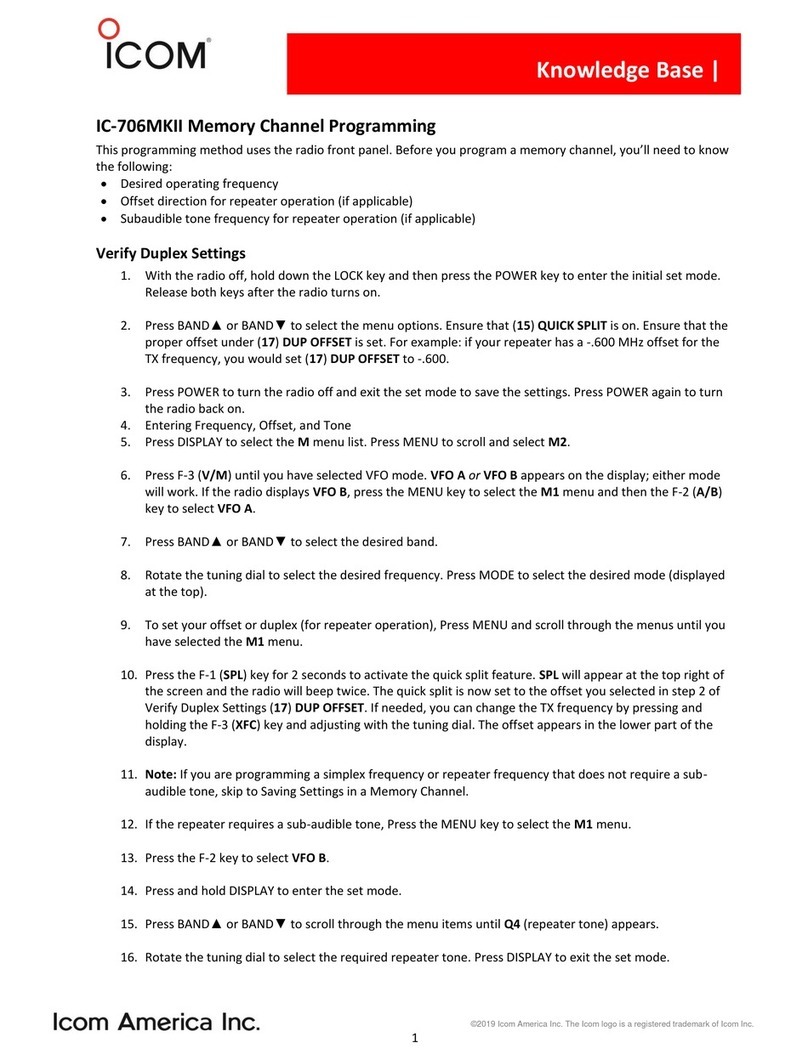
Icom
Icom IC-706MKII Owner's manual
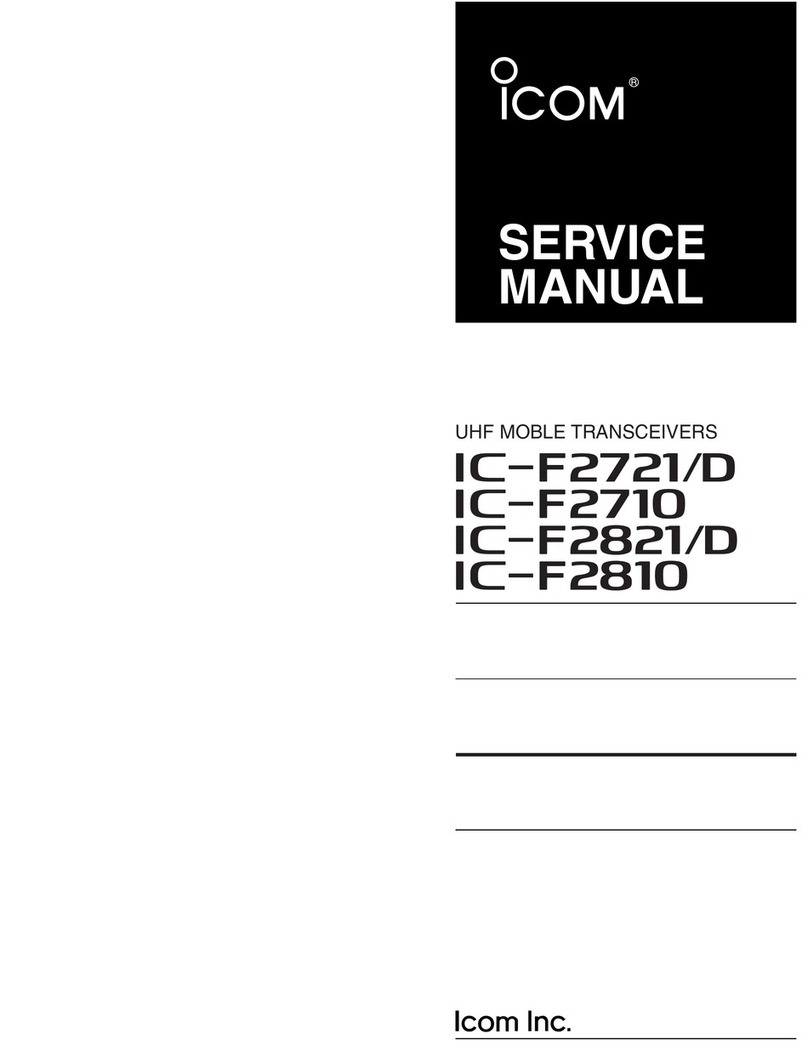
Icom
Icom IC-F2721 User manual
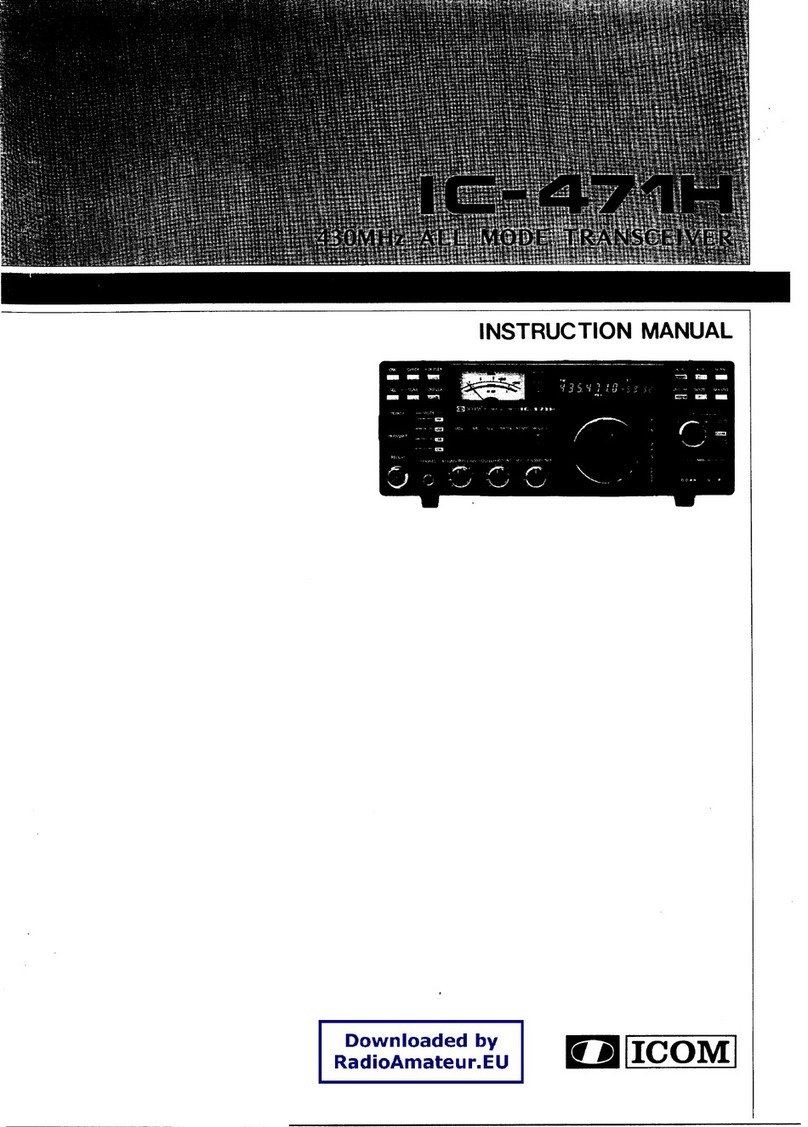
Icom
Icom IC-471H User manual
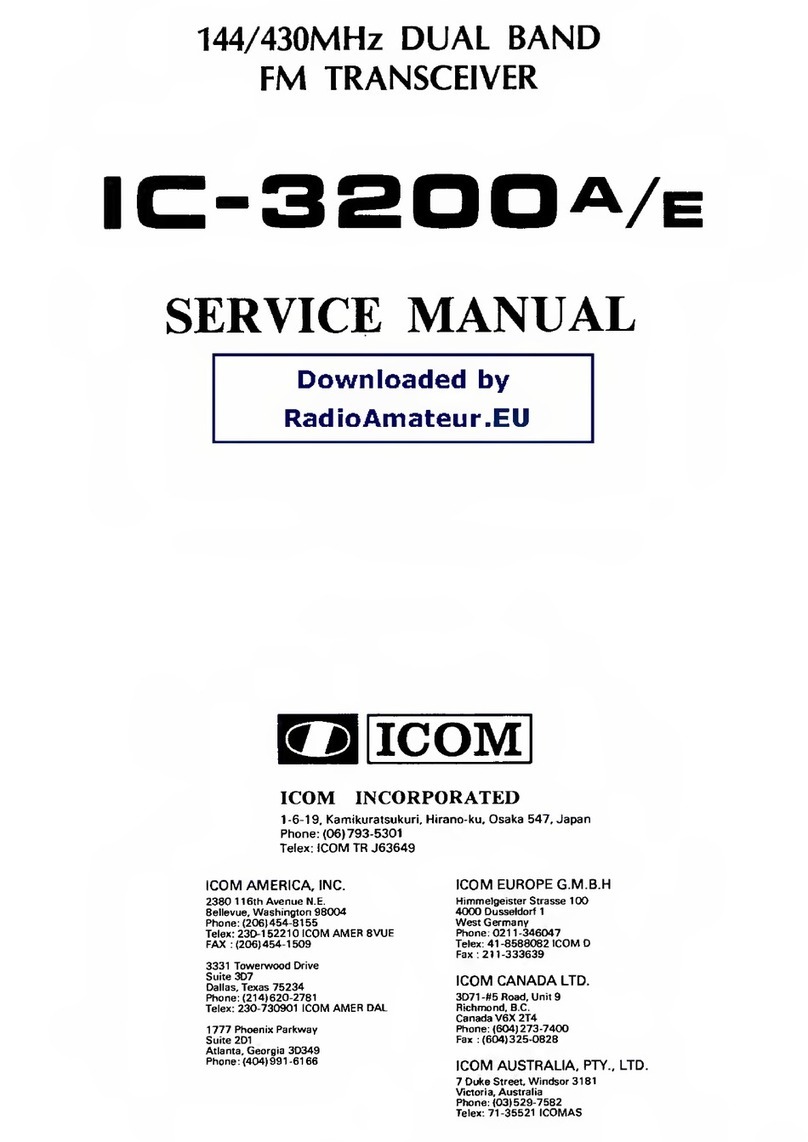
Icom
Icom IC-3200A User manual
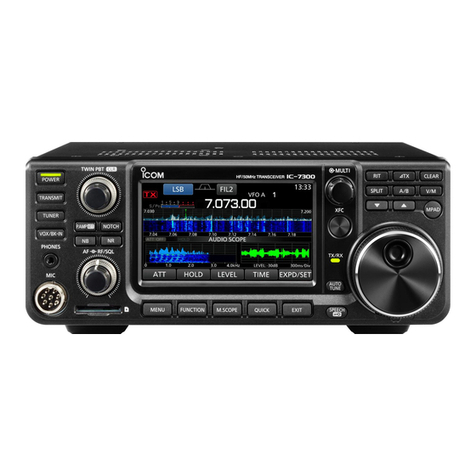
Icom
Icom IC-7300 Installation instructions
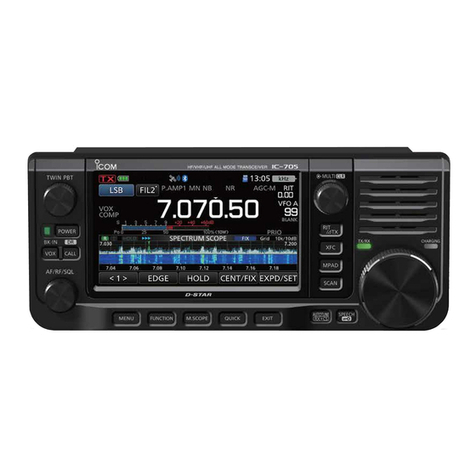
Icom
Icom IC-705 Installation guide
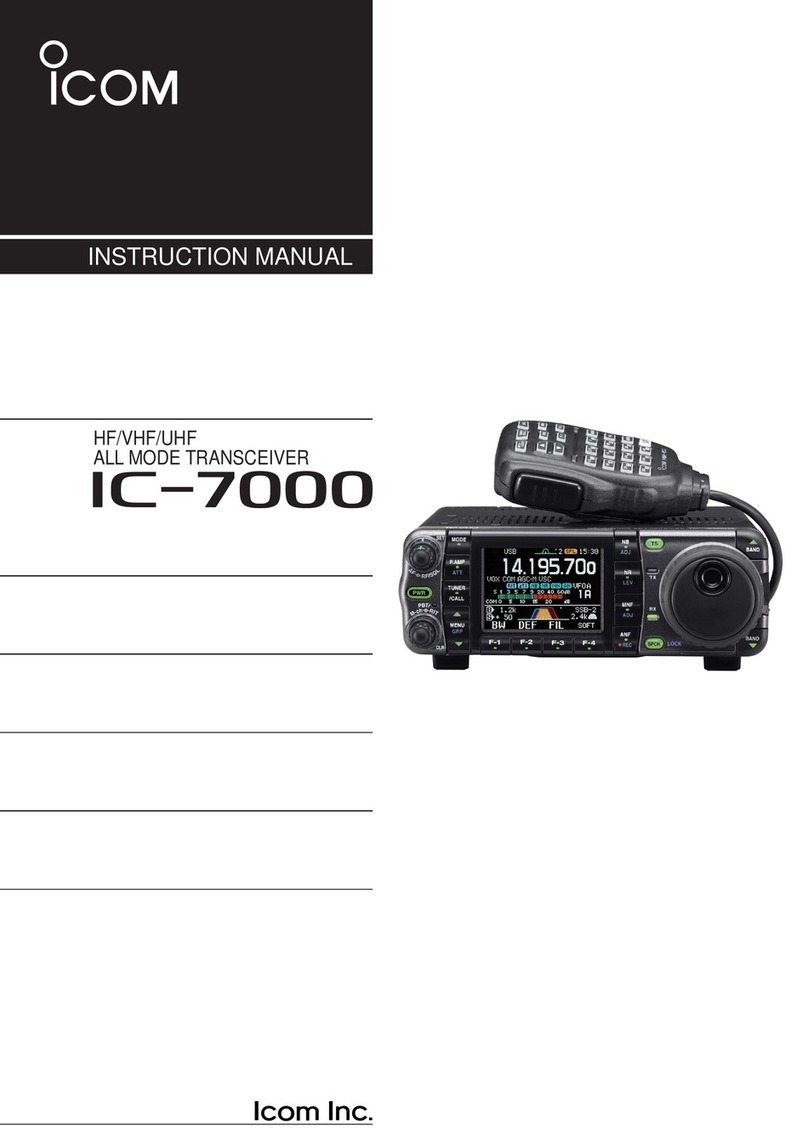
Icom
Icom IC-7000 User manual
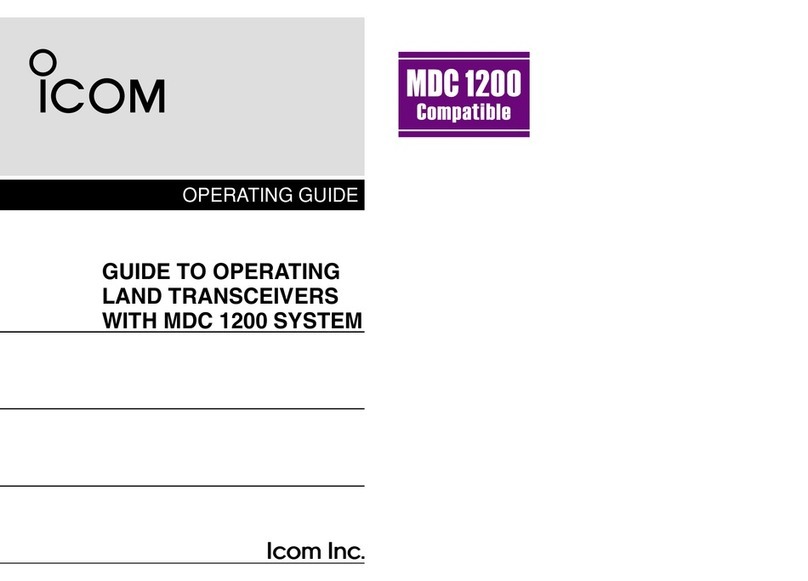
Icom
Icom IC-F1700 User manual
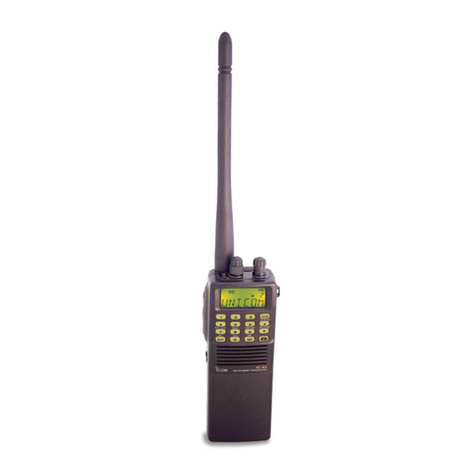
Icom
Icom IC-A3 User manual
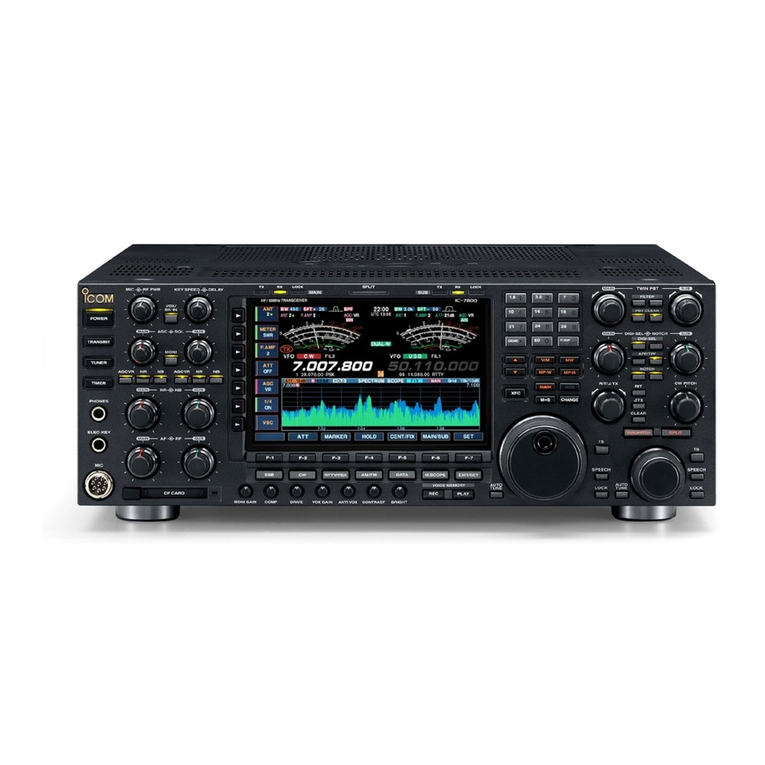
Icom
Icom IC-7800 User manual
